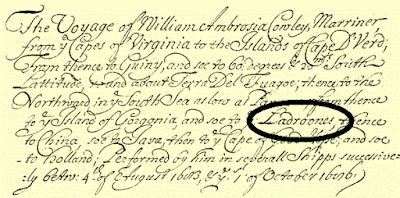Ladrones (thieves; in this case pirates) visit the Ladrones
Much of that wealth was transported on ships. Piracy was an important part of the competition between European empires over the wealth of the rest of the world.
Rather than fight another expensive war between states, England, for example, could allow British pirates to raid Spanish ships, bringing that captured wealth into British circulation.
William Ambrosia Cowley was the navigator of one of these British pirate ships, the Nicholas, commanded by John Eaton. Headed for Manila and then China, the Nicholas stopped by Guam in March of 1685. To our good fortune, Cowley wrote about his experiences at Guam.
STILL SEMI-INDEPENDENT
The Chamorros these Englishmen met were still, in part, in rebellion against the Spaniards and living life as they knew it before the Spaniards arrived. They walked about completely naked, still used spears and slings as their weapons and still mastered their canoes on the open sea. The lances were tipped with the sharpened bones of the dead. Even then, the Chamorros prized the iron of the Europeans, bartering for whatever pieces of iron, such as old nails, the British were willing to give up. Amazingly, the Chamorro men were still equally at home in the sea as they were on land. Even with their hands tied behind their backs, the English saw Chamorro men they had captured jump overboard and swim long distances to safety while being shot at.
The Chamorros were treated with suspicion by the pirates. They would approach the British for trade in one instance, then turn and attack the British in the next. The Chamorros also asked the British if they could team up and wage mutual battle against the Spaniards. The pirates turned down the suggestion.
CHANGES CAME FAST
The Europeans also learned from the people and the environment of the islands they conquered. A Jesuit priest went on board the pirate ship and taught the British how to make coconut milk from squeezing the grated coconut meat after some water had been added.
We also see that the military strength of the Spaniards on Guam in 1685 was just 600 soldiers, a figure that many scholars agree on as the average number.
FOR SOME CHAMORROS, DEATH....
The Spanish governor, too, received gifts from the British.
Some Chamorros probably got the iron they coveted but not much else. And some Chamorros died, being shot at by the British when they lifted their hands against those pirates. They also failed to get the help they wanted from the British to end Spanish rule in their islands.
From Cowley's book, including his visit to the Ladrones (encircled)


No comments:
Post a Comment